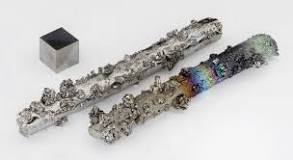Tungsten
Tungsten (also called wolfram) is a chemical element; it has symbol W and atomic number 74. Tungsten is a rare metal found naturally on Earth almost exclusively as compounds with other elements. It was identified as a new element in 1781 and first isolated as a metal in 1783.
Current uses are as electrodes, heating elements and field emitters, and as filaments in light bulbs and cathode ray tubes. Tungsten is commonly used in heavy metal alloys such as high speed steel, from which cutting tools are manufactured. It is also used in the so-called 'superalloys' to form wear-resistant coatings.

